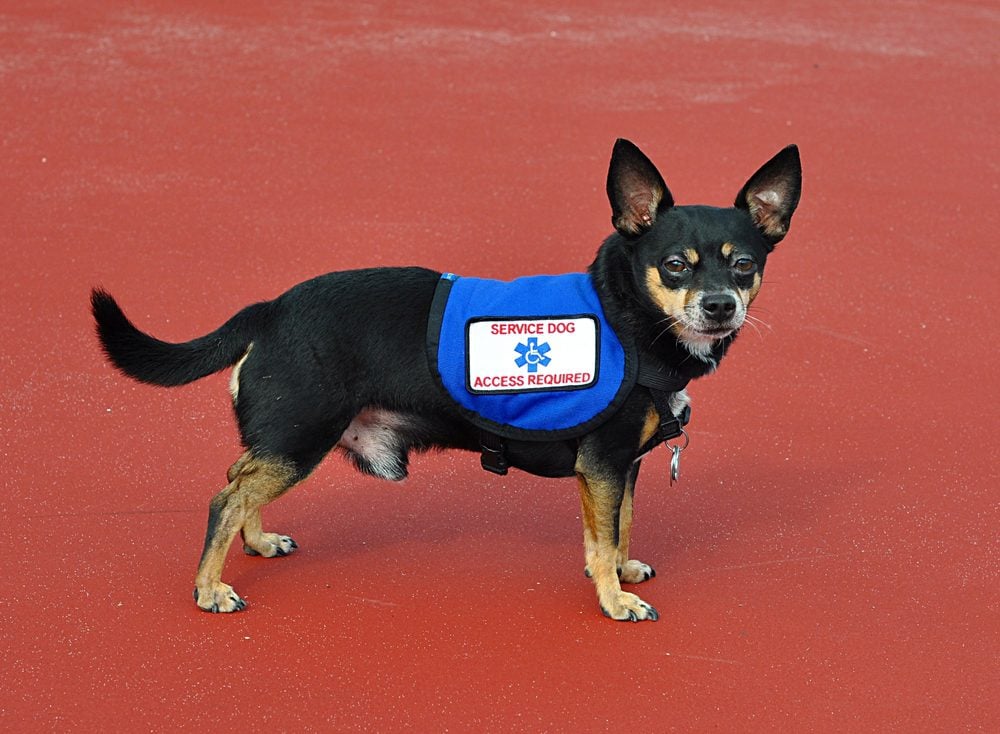When you think of a service dog, what is the first image that comes to mind? For many of us, it is probably that of a Labrador retriever working as a guide dog. However, there are many different types of service work that dogs can do, and the size of the dog doesn’t always matter.
Though many of us don’t immediately think of small breeds as service dogs, they can be just as good at service work as large breeds are. Their size comes with both benefits and disadvantages. If you’re looking for a service animal and are considering getting a small dog, then this article is for you!
This article will discuss the pros and cons of small dogs for service work as well as what tasks they can perform. Finally, we’ll share the five best small breeds for service work and tell you all about them.
Pros of Small Service Dogs
Obviously, small breeds can be amazing service dogs. Depending on your circumstances, they could even be a much better choice than a large breed. Let’s look at some of the advantages of small breeds as service dogs.
Less Expensive
Because of their size, small dogs tend to be less expensive than large dogs. They eat less food which lowers the cost of kibble. When they need medication, the dose is lower and thus often cheaper. Even groomers may charge less for a small breed because it doesn’t take as long to groom them.
Less Energy
Small breeds tend to have less energy than large breeds. Even if you were to adopt a high-energy small breed, they would require less exercise than a high-energy large breed.
Dogs, especially high-energy large breeds, can be a lot of work. If you’re worried about meeting a dog’s exercise needs, it’ll be far easier to do so with a small breed. Some small breeds need very little exercise and can even be exercised indoors.
Easy to Travel With
If you like to travel, having a small service dog can be easier. Service dogs can be with you on airplanes, but large breeds may feel cramped. It is much easier for a small breed to rest at your feet, under your seat, or even in your lap.
The same is true for other types of public transport. Those with large service dogs often have to carefully plan how they will fit themselves, their companions, and their service dog onto transportation.
Some have to pay more for extra space, such as opting for a larger vehicle in transportation apps such as uber. With a small service dog, you won’t have to make these considerations as it should be easy for them to sit at your feet or even in your lap if necessary.
Great for Apartment Living
A tiny apartment won’t feel cramped if you’re living with a small service dog instead of a larger service dog. It also won’t be a problem not to have a yard, as many small breeds need no more than a short walk for exercise. Often, small breeds can also be exercised indoors through play.
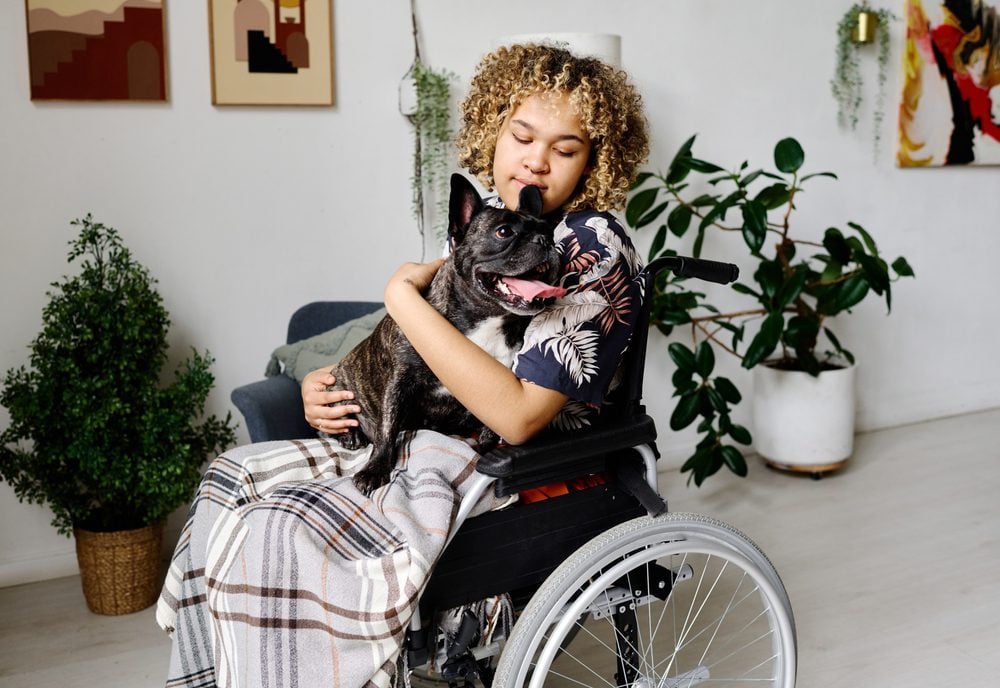


Cons of Small Service Dogs
There are many benefits to having a small service dog, but as you can imagine, there are some disadvantages as well. These may not be dealbreakers for those interested in a small service dog, but it’s important to know the cons so that you can make an educated decision about whether or not a small breed is a right choice for you.
Can’t Perform Strenuous Tasks
As you know, small dogs aren’t very strong. As such, they can’t help with strenuous tasks like offering mobility support, pulling wheelchairs, or pulling and holding doors open. They’re also unable to be guide dogs as they must be tall enough for their handlers to comfortably hold onto their harnesses.
May Not Be Perceived as Service Dogs
Unfortunately, there is a bit of stereotyping around service dogs. When most people think of service dogs, they tend to think of large breeds such as Labradors, golden retrievers, German shepherds, or Bernese mountain dogs.
Because of this, people may be more likely to attempt to pet your service dog, especially if the dog is not wearing an identification vest (though you are not legally required to put an identification vest on your service dog). You may also run into issues with businesses thinking you are trying to bring a pet in when your small dog is not a pet but a service animal.
Service Work Small Breeds Can Perform
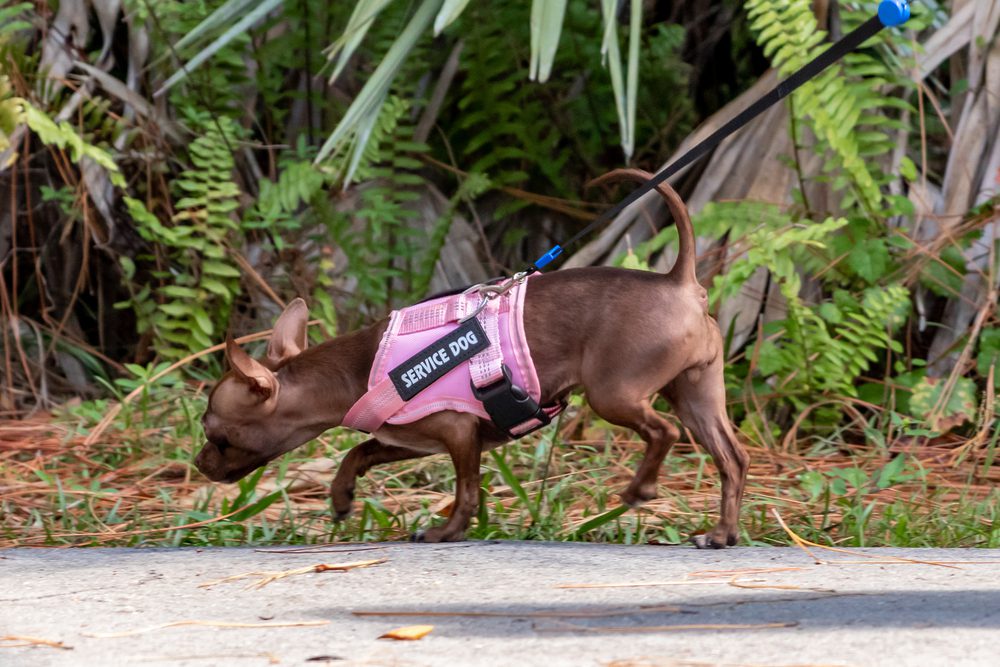


Dogs can be trained to help people with all sorts of disabilities. This is why service dogs don’t always have to be large; they only have to be capable! Here, we will share some of the different types of service work that small dogs can do.
Medical Alert Dog
“Medical alert dog” is an umbrella term for any service dog that alerts their handler to an impending medical crisis. Some examples of medical alert dogs include seizure alert dogs, tachycardia episode alert dogs, and diabetic alert dogs.
Seizure alert dogs communicate with their handlers when a seizure is imminent. Tachycardia can often cause fainting spells, and tachycardia alert dogs can identify when their handler’s blood pressure or heart rate is abnormal.
Diabetic alert dogs detect changes in blood sugar and notify their handlers when blood sugar levels are nearing dangerous zones. Medical alert dogs are important because their intervention enables their handlers to get to a safe place where they will not hurt themselves should they faint or have a seizure.
Not only that, medical alert dogs can quite literally save lives by notifying their handlers before their health has reached a state of emergency. Once alerted, handlers are able to take appropriate medication to prevent these emergencies.
Hearing Dogs
For those who are deaf or otherwise hearing impaired, hearing dogs can provide a sense of independence and security. Hearing dogs alert their handlers to various sounds, such as alarms, doorbells, or even crying children.
These dogs are typically trained to paw their handlers and then lead them to the sound. Though hearing dogs won’t alert to common ambient sounds, their handlers can garner important information from their service dog’s behavior, such as if a car or person is approaching from behind.
Psychiatric Service Dogs
Psychiatric service dogs help people who suffer from mental traumas such as anxiety, depression, PTSD, and more. Though large dogs can sometimes be preferable for this role to provide heavier deep-pressure therapy (the dog acts as a weighted blanket), small dogs can also be psychiatric service dogs.
Though small dogs are not as heavy as large dogs, some still find their weight comforting, so they can be trained to sit on someone’s lap to help calm them (this is also a form of deep pressure therapy). The tasks for this line of service work also may involve interrupting repetitive or self-harming behaviors and providing grounding.
Some psychiatric service dogs can wake their handlers from nightmares and help them prevent panic attacks. Psychiatric service dogs can also lead their handlers out of overwhelming areas while in public.
Top 5 Small Breeds for Service Work
Any breed could potentially make a great service dog. It is all about the individual dog’s personality. However, some traits may make a dog more likely to be suitable for service work. Friendliness, intelligence, and an eagerness to learn are all important characteristics for a service dog to have.
Though we don’t want a service dog to interact with other people while working, friendliness is still important as a service dog that is fearful, timid, or even aggressive around others simply wouldn’t be able to perform their duties. Intelligence and an eagerness-to-learn speak for themselves.
Though any small breed could be a great service dog, we’ve found some that exemplify the traits that we’ve just discussed. Let’s take a look at some of the best small breeds for service work!
1. Cavalier King Charles Spaniel



The cavalier King Charles spaniel is a fantastic choice for a small breed service dog because they have a lovely disposition and are quite versatile. By versatile, we mean both that they are capable of participating in a variety of different activities and that they’re able to adapt to your lifestyle, whether it is active or sedentary.
Some of these activities include canine sports such as agility, rally, and obedience. While you’re interested in service work and not dog sports, the King Charles spaniel’s ability to excel in these events is a testament to their overall intelligence and capability.
Though they have what it takes to participate in athletic events, they are not considered high-energy and do not need as much exercise as you might expect. Instead, they’re happy with a daily walk.
The cavalier King Charles spaniel is friendly, affectionate, and sweet, and they’re especially loving with their families. They get along well with kids, strangers, and other dogs. They are also smart and eager to please, making them easy to train.
The cavalier King Charles spaniel requires only a moderate amount of maintenance. A quick daily brush is enough to keep the coat from tangling and matting and to reduce excess hair around your home. Their teeth should also be brushed daily as they are prone to periodontal disease.
2. Toy or Miniature Poodle
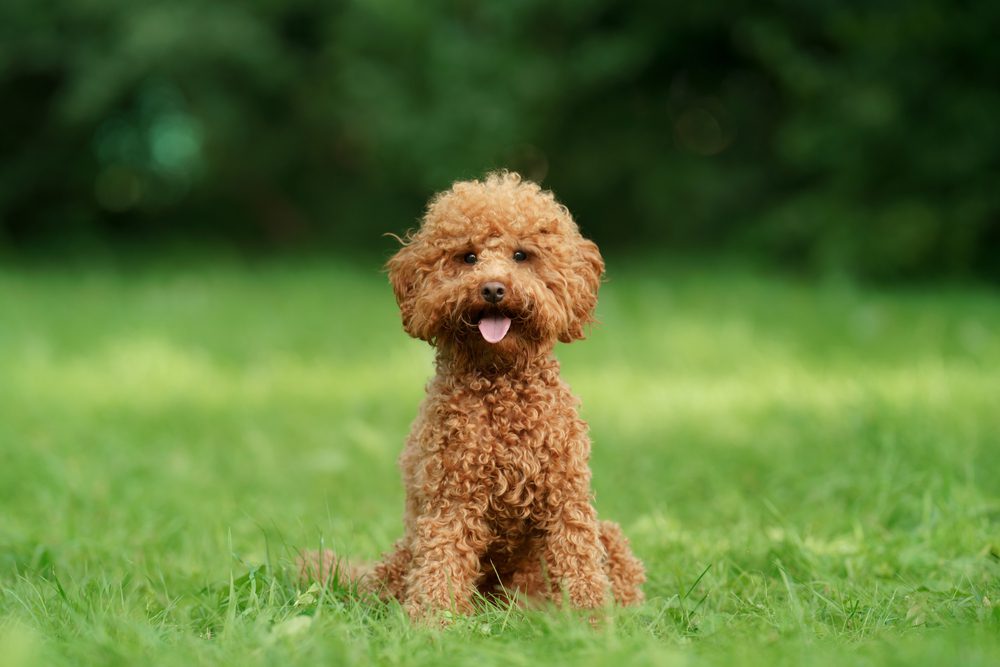


Poodles are one of the smartest breeds in existence. Because of this, they can make for incredible service dogs. Luckily, they come in smaller sizes, such as the toy (4-6 pounds) and the miniature (10-15 pounds).
Poodles adore their families, are good with kids, and are friendly toward strangers. They may take some time to warm up to other dogs, but with proper socialization, they will not have any problems making friends.
Because they were originally bred to be hunting dogs, poodles have a lot of energy and love to retrieve. Fetch is a great way to exercise this breed, and their propensity for retrieving items can also be useful for service work as they can easily be trained to retrieve items for you, including medications.
If you’re active and need a service dog near you at all times, the poodle should have the energy to keep up despite being small. Even though toy and mini poodles are high-energy and athletic, their small stature means they won’t need the exhaustive amount of exercise a standard poodle typically needs. An hour of exercise per day is often enough.
If you’ve wanted a service animal but struggle with allergies, it’s possible that a poodle could be the answer. This is because their fur is similar to that of a human. It takes years for a poodle’s hair to grow to its full length, and the hair is only shed once it is ready to be replaced by new hair. That is to say, poodles do not shed very much at all.
The tradeoff is that you will need to have your poodle professionally clipped every four to six weeks (or learn how to do it yourself). Otherwise, you’ll spend a lot of time brushing their hair every day.
3. Bichon Frise



Bichon frises have stellar personalities and are highly trainable. In fact, after the French Revolution, bichon frises lost their place as nobility’s lapdogs and became circus performers who wowed audiences with their tricks!
Bichon frises are incredibly friendly and do not know the meaning of strangers. They do well with kids and other dogs and are very loving toward their families. In fact, they are so attached to their families that they can develop behavioral issues if left alone for too long.
Luckily, a bichon frise would always be by your side as a service dog, and they certainly have what it takes to become one. Bichon frises are considered easy to train and are known for being quick learners. So it’s no surprise that these former circus dogs can learn the complex tasks required of service work.
In terms of energy levels, bichon frises have a moderate amount of energy. They may lie around the house for hours, but they absolutely love to play and often wake up from a nap ready to move. As such, they need to be walked and played with daily.
Much like the poodle, the bichon frise has a low shedding coat that is easy on people with allergies. But, once again, the tradeoff is that their coat will need professional grooming to keep it short and easy to manage.
4. Yorkshire Terrier
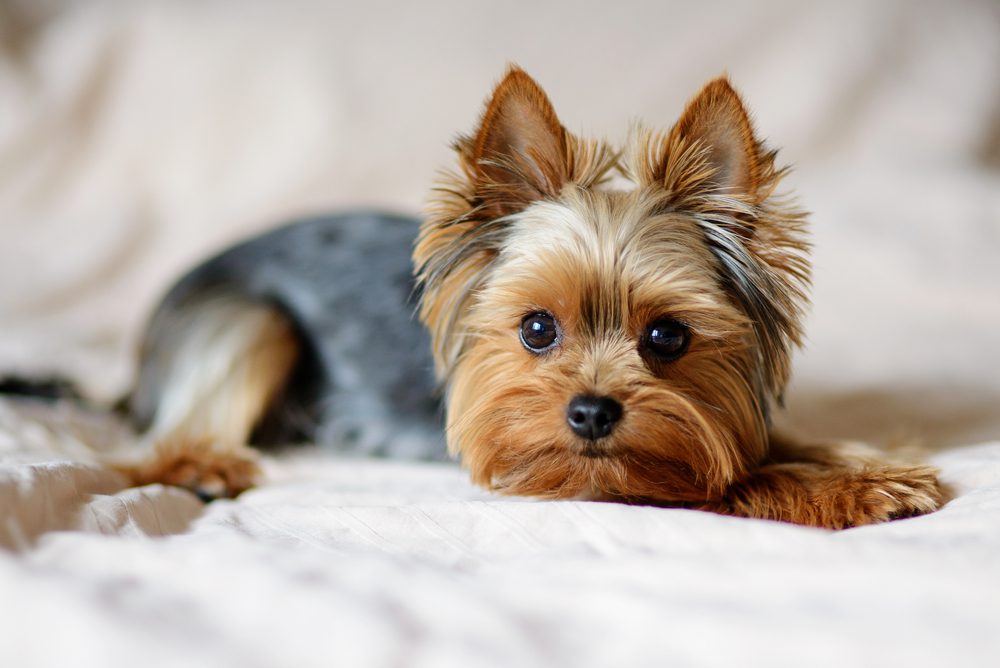


If you’re not into curly-haired breeds like the poodle or bichon frise but need a dog with a hypoallergenic coat, then you may want to consider the Yorkshire terrier. They have long, straight hair that hardly sheds.
Just like the other hypoallergenic breeds, you’ll likely want to have this dog clipped regularly by a groomer. Otherwise, you’ll spend a fair amount of time maintaining the coat to keep it from getting matted.
In terms of personality, the Yorkie is a lover. These dogs absolutely adore their families and always want to be around other people. They see strangers as friends, are great with children, and can also get along with other dogs.
Because they are so loving, they are eager to please their owners. This, paired with their intelligence, makes them easy to train. Yorkies are capable of participating in canine sports such as rally, agility, and obedience and are even known for becoming fantastic therapy dogs. As such, there’s no reason why they couldn’t also be great service dogs!
Yorkshire terriers are not a high-energy breed and are quite small (7 pounds), so they don’t need much exercise. However, two short walks per day as well as some spontaneous play sessions, are enough to keep them in good spirits.
Their moderate to low energy level should be taken into account when considering this breed for service work. A Yorkie may not have the energy and endurance to keep up if you’re highly active. However, they are light enough to be carried easily.
5. Pembroke Welsh Corgi
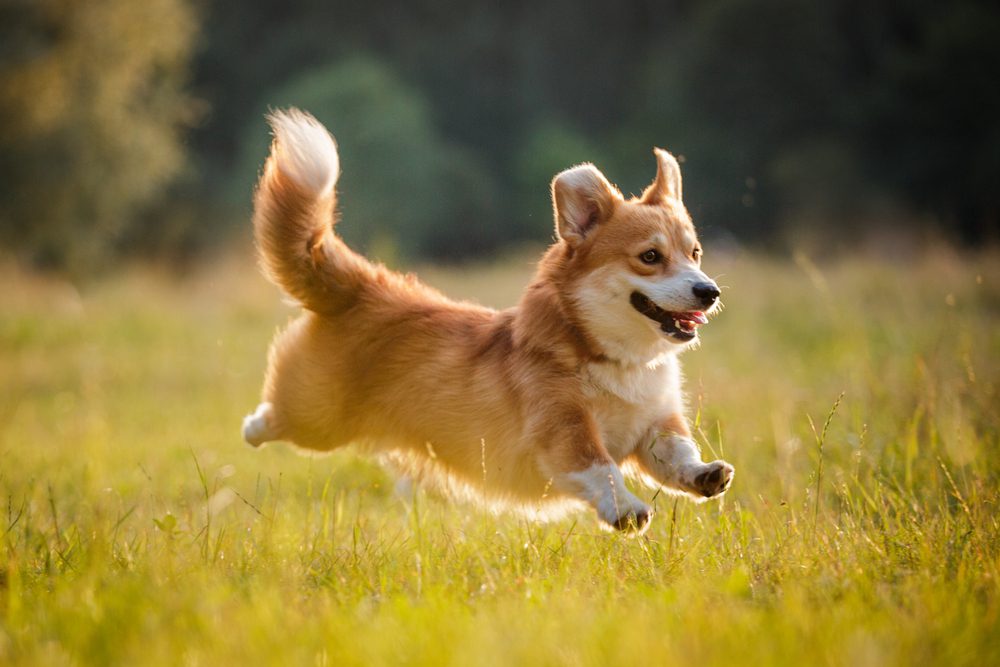


The biggest breed on our small dogs list, the Pembroke Welsh corgi, can weigh up to 30 pounds. A corgi is a great option if you need a compact-sized dog with endurance and energy. This breed is actually a herder and, thus, is quite strong and athletic despite being on the smaller side.
Corgis are especially affectionate with their families, but they also do well with strangers and other dogs. They’re typically okay with kids but may try to herd toddlers.
Corgis can make excellent service dogs because they are highly intelligent and love having a job to do. They can be a bit independent but are overall willing to learn and respond well to positive reinforcement training.
While corgis are athletic enough to herd big animals like cattle, they don’t need as much exercise as you may expect. They do love physical activity, but an hour of exercise per day is usually enough. This can be a long walk or even a jog, but don’t expect a corgi to be able to keep up with a bike — their legs are too short, and this is too hard on them.
In terms of grooming, corgis are the most low-maintenance option on this list. They do not need professional grooming or even daily brushing (although daily brushing can help reduce hair in your house!). They shed a lot, so brushing them at least once per week is recommended.
A Hero in a Small Package
When it comes to service work, size doesn’t always matter. While guide dogs or mobility assistance dogs do need to be large, medical alert dogs, hearing dogs, and psychiatric service dogs can be any size. Small dogs certainly have a place in service work. Some heroes come in small packages!
